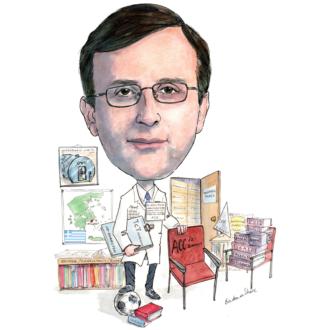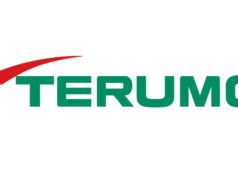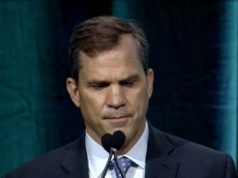
George Dangas, chair of the American College of Cardiology interventional scientific council and member of ACC.i2 executive committee, has left Columbia University in August 2010, where he had been since 2004, for Mount Sinai Medical Center, New York, USA. In this interview, Dangas, who is also co-director of Transcatheter Cardiovascular Therapeutics (TCT) conference, spoke to Cardiovascular News about his career, research and challenges facing interventional cardiology today.
How did you become interested in medicine? Why cardiology?
Medicine is both an art and a science. The quest for understanding the different systems and functions of the human body, and the strategies to accurately diagnose and effectively treat the pathologic conditions is the science of medicine. How to best use this knowledge to apply and positively affect the life of a single patient is the art of medicine. Both have always been fascinating to me.
The cardiovascular system is intimately related to physics and this had always been of great interest to me from a very young age. Furthermore, it is one of the fields in medicine, where the therapies affect the patient’s life immediately and most of the treatments are evidence based.
Hence, I decided to go into the field of cardiology in the middle of my internship year, realising early that many therapeutic interventions are and can be made available for treatment of cardiovascular disease (the number one killer in the USA) and that I can make a difference.
How has it evolved since you began your career?
The evolution has been tremendous over the past 16 years since I started my training in cardiovascular medicine. During this period, there has been the exponential progress in percutaneous treatment of coronary and peripheral arterial disease, compared to any previous time period in the history of medicine. This progress has affected all areas of cardiology including and not limited to: acute myocardial infarction therapies (both pharmacology and device-based therapies), pharmacologic therapies to enhance both safety and efficacy outcomes in acute coronary syndromes, coronary interventions with drug-eluting stents (now with third generation drug-eluting stents), emerging heart failure devices as adjunct to medical therapy, angiogenesis and cell therapy, and finally an important focus on structural heart disease (valvular and congenital). The entire field has matured with a new focus on the patient and strategies to improve clinical outcomes.
Vascular disease has become a subject of global interest, with more research and therapeutic options than ever before and a great promise for the future. Our work with several other specialties has brought interdisciplinary medical, surgical and interventional teams and the idea of integrated cardiovascular institutes to life.
Interestingly, we have also experienced a return to haemodynamics with the new wave of valve therapies and this has been fascinating to me as it has brought the physics part back in an intense way.
What are your current areas of research?
Research in clinical outcomes with new devices and adjunctive pharmacological therapy is my area of focus. My interest and quest has always been to figure out how to predict and avoid clinical complications. This requires detailed analysis of outcomes of patients and evaluating predictors of important safety and efficacy endpoints in all populations.
Lesser invasive and innovative technologies with a focus on improving clinical outcomes require attention to both early (feasibility) and pivotal trials to prove safety and effectiveness. These technologies in combination with enhanced pharmacotherapy will be the focus of my current and future studies. Notably, these new approaches certain target areas of medicine in a highly specific way and have the potential of a very significant future impact.
Adjunctive pharmacology faces the quest for more individually tailored therapy and although we are still working toward individualised genetic determined therapies, evaluation of the risk profile of patients and their likelihood to benefit from or be harmed by a therapy takes centre stage. This requires comparative effectiveness research in all comers, which is of keen interest to me.
One of the major messages of recent years is that both interventional and surgical procedures are not any kind of guaranteed or permanent “fix” and well-targeted medical therapy is essential as an adjunct to procedures for all patients with cardiovascular disease.
What are the major challenges facing interventional cardiology today?
The very difficult and cumbersome regulatory pathway for device approval today is a very important challenge for growth of innovation, which is usually initiated by small companies with limited recourses. This has resulted in many small companies with promising therapies to halt their progress.
Interventional cardiologists strive to maintain high quality work, as far as appropriateness of procedures and clinical outcomes in an ever increasing judgmental environment. This is another important challenge for us today. Our goal must be to keep this subspecialty at the highest integrity and quality.
In my current role as the chair of the Interventional Scientific Council and Section of the ACC, and as a former trustee of SCAI, I hope to be able to contribute to the development of initiatives to help address the above as well as other challenges with the assistance of our professional organisations.
What do you hope to achieve as director of Cardiovascular Innovation at Mount Sinai Medical Center, NY?
I hope to be able to integrate Mount Sinai’s tradition for robust and excellence in clinical care and bedside teaching with my keen interest in clinical and translational research by incorporating innovative therapeutic approaches. This will require collaboration amongst the already well established and successful constituents of the Cardiovascular Institute at Mount Sinai Hospital, with a multidisciplinary approach focused to improve clinical outcomes in our patients and to further enhance our knowledge.
In the coronary field, our aim would be to enhance current technologies and convert complex and high risk procedures into simpler and safer ones. The use of hybrid procedures for treatment of vascular/valvular/coronary disease is an example of such enhancements.
More importantly, I hope to involve many different specialties to work together and develop new programmes for patient care, education and research that would fit the traditions upheld by Mount Sinai for so many years.
Which techniques/technologies in the field of nonsurgical cardiac and vascular interventions will you be watching closely in the future?
The developments in the field of structural heart disease will dominate most headlines in the next few years. This will begin with the introduction of the prototype devices for treatment of valvular heart disease (aortic and mitral), as well as left atrial appendage and creative use of endocardiac defect closure devices.
Heart failure and haemodynamic support devices will also include several emerging applications. Interestingly, both include the use of large bore vascular access, necessitating the need for development of new vascular closure techniques.
Finally, endovascular interventions will improve tremendously such that devices will be even more user-friendly and smaller in size with enhanced outcomes than they are today.
Which developments have fascinated you so far in your roles as chair of the ACCi2-2010 and co-director of the annual Transcatheter Cardiovascular Therapeutics (TCT) conferences?
Continued medical education for interventional cardiologists is an essential component of growth and development in our field. There is tremendous quest for cutting-edge knowledge within our specialty!
The primary focus of ACCi2 and TCT has been on high quality scientific content and application to clinical practice. Over the years, I have found that attendees are much more engaged in the meetings and their various functions. This has been facilitated by the increasing incorporation of technological advancements such as the broad use of audience-response systems, dissemination of important results through the internet, live case demonstrations, widespread re-emergence of practical case-based discussions and of course use of simulation and web-based education.
Board certification has also become much more interactive and web-based. This is the 12th year of the annual Board Review course, that I have been chairing, and I continue to be very interested in attending it myself given all the new teaching and interactive features we incorporate every year!
Who has inspired you in your career and what advice of theirs do you remember today?
This question brings to mind many distinguished individuals who have influenced my career, but in choosing only one, I have to gravitate towards the one who is no longer with us. Dr Richard Gorlin was inspirational because of his very simple, yet innovative way, to merge hydrodynamics into human haemodynamics. I had the honour to be his last fellow and his advice for constant attention to professional integrity despite any environmental trends has always stayed with me.
Could you describe some memorable cases you have treated?
There are many memorable cases with good and bad results, each teaching me something important and adding to my experience. Certainly the top one was a presumed dead person with cardiogenic shock who came to the cath lab under a cooling blanket! He had severe left main disease and had sustained many ventricular fibrillation arrests on the way. He ended up leaving the hospital alive and well.
I think everyone probably remembers the youngest patient they treated with an acute myocardial infarction. I remember vividly how disappointed I was when the angiogram revealed multivessel disease in an unfortunate 22-year-old smoker.
What have been your proudest moments?
Graduation with first rank from University of Athens Medical School, completion of the Hyperbaric Medicine training in the Navy Seals unit and admission for Cardiology Fellowship at Mount Sinai. More recently the most significant and proud moments for me have been representing interventional cardiologists in the American College of Cardiology Interventional Scientific Council as chairman and my selection as a trustee of the Society for Cardiovascular Angiography and Interventions few years ago.
What is your opinion of the revised healthcare system in the US?
While the idea of universal healthcare seems right for all Americans, I am not sure I have fully understood how the new health insurance system will actually accomplish this. The devil is always in the details and the amendments introduced over time.
In general, the goal is for patients to have more access to health insurance. I certainly hope the companies make good use of their widened clientele and broader jurisdiction. I would feel better if the insurance field was dominated by non-profit organisations and I would like to see the professional organisations play a more dominant role.
From the physicians’ perspective, it will most likely affect practitioners in solo or small practices rather than large medical centres. This is obviously concerning, since many patients value their relationship with their doctor. Somehow we all (insurance companies, hospitals, doctors, administrators, patients) have to strive and seek for high quality in healthcare in order for the system to succeed.
Outside of medicine, what other interests do you have?
I enjoy travelling and soccer. I always follow the developments in Greece and keep in touch with old friends. My children have made me rediscover my interests in foreign languages, math and sciences.
Fact file
Positions
Present status
Professor of Medicine, Division of Cardiology, Mount Sinai School of Medicine, New York, NY
Director, Cardiovascular Innovation, Zena & Michael A. Weiner Cardiovascular Institute, Mount Sinai Medical Center, New York, NY
Chair, Interventional Scientific Council and member of ACC.i2 Program Executive Committee, American College of Cardiology, Washington, DC
Director of Academic Affairs, Cardiovascular Research Foundation, New York, NY
Education
1999 PhD-DrScMed: National Kapodistrian University of Athens
1990 DHM: Naval School of Hyperbaric Medicine, Hellenic Navy, Athens
1989 MD: Medical School, National Kapodistrian University of Athens
1983 Baccalaureate: Athens College
University appointments
2004–2010
Associate Professor of Medicine, Division of Cardiovascular Disease, Columbia University Medical Center, New York, NY
2001–2002/2003–2004
Clinical Associate Professor of Medicine, New York University School of Medicine, New York, NY
1999-2001
Assistant Clinical Professor of Medicine, George Washington University
Memberships
2006 Fellow, Society for Vascular Medicine & Biology
2006 Fellow, American Society of Angiology
2005 Member, Board of Trustees Society for Cardiovascular Angiography & Interventions
2003 Fellow, Society for Cardiovascular Angiography and Interventions
2000 Member, International Society of Endovascular Specialists
1999 Fellow, American Heart Association (FAHA), ATVB Council
1999 Fellow, American College of Cardiology (FACC)













